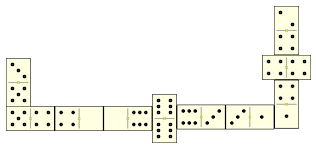Domino Line Games
This is the most widespread type of domino connecting game, in which the layout is a single connected chain of tiles, with both ends open so that it can be extended in either direction. Traditionally, tiles with unequal ends are played in line while doubles are played crosswise. Since lines can easily become too long to fit on the table if they were straight, they can be made to turn corners when convenient as in the illustration below. This has no effect on the game.

Here is a list of traditional and invented domino line games on pagat.com.
Notes on the index
Invented games, mostly submitted by readers of pagat.com, are listed in italics.
- Players
- The preferred number of players is shown in bold. Other numbers with which it is possible to play are shown in grey.
- Equipment
- Western domino sets are indicated by the highest number of pips on a tile end - for example [6:6] is a standard double 6 set of 28 tiles, [12:12] is a set of 91 tiles with up to 12 pips on each end.
- Game Type
- Indicates the game's matching rule (for example 'equal ends) and objective (for example 'shedding' if the aim is to be the first to get rid of all one's tiles) and other families to which the game belongs.